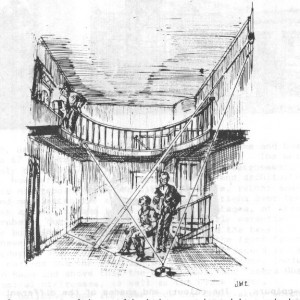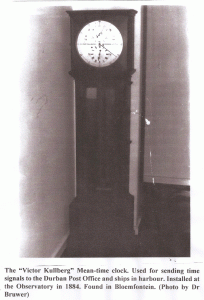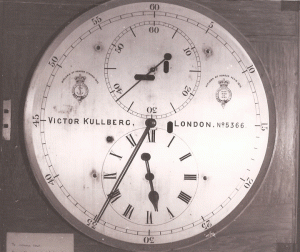|
|||
INSTRUMENT: Calendar
Description: Perpetual Calendar
(revolving centre pieces)
Location: South African Cultural History Museum (M:E:231)
Source:
-(R13)
Photo Gallery
Location: Observatory Museum Grahamstown
Source:
-(R14)
Location: The Union (Republic) Observatory.
Source:
-Moore, P. & Collins, P.; Astronomy in Southern Africa, p.103.
(Note) The Republic Observatory was the timekeeper for South Africa. When Jan Hers started working there (Rep. Obs ?) in 1947, there were 5 pendulum clocks for time keeping. Three of them were Riefler clocks (German?) When the Observatory received the quartz clocks the old pendulum clocks were kept for a few years and then sold. It wasn’t a public auction, but there was a call for bids. Where are these clocks now? When the Republic Observatory closed down, Jan Hers became timekeeper at the C.S.I.R. Apparently the clocks from the quartz clocks onwards are still at the C.S.I.R. [Personal conversation with Jan Hers at Sedgefield on 29 Apr. 02; CL]
Description: Clock of Father Tachard
The clock that Father Tachard used when he visited the Cape in 1685. He had a clock that showed seconds.
Source:
-John Harrison Tercentenary, MNASSA, Vol. 52, Nos. 7 & 8, 1993 Aug.
The Cape Observatory received a new Harrison clock as one of its first instruments. (Circa 1827) (Could it be a clock made by Harrison who solved the longitude problem?) Where abouts unknown.
Source:
-Laing, J.D. (ed.), The Royal Observatory at the Cape of Good Hope 1820 – 1970 Sesquicentennial offerings. p. 3.
Crystal clock system installed at Cape Observatory during the directorship of Stoy (1950 – 1968).
Source:
-Laing, J.D. (ed.), The Royal Observatory at the Cape of Good Hope 1820 – 1970 Sesquicentennial Offerings. p. 17.
Description: Kullberg Mean Solar Clock
The clock, no. 5366, was built by Victor Kullberg of London. It was installed at the Natal Observatory in 1884. The clock was electronically connected to the post office as well as the timeball where it served as the timekeeper for the Natal Colony (today Kwazulu-Natal) and later the Union of South Africa (today the Republic of South Africa). The Observatory closed down in 1911 and the clock was moved to the Union Observatory in Johannesburg. There it was displayed in the library until the observatory closed down. The last professional observer of the Union Observatory (then called the Republic Observatory), Dr. Bruwer, took the clock. It passed on to his family who moved to Paarl, Western Cape Province. Current location unknown. [Personal communication with Andrew Gray; CL]
Below is a photo of the clock. No detail can be made out on the photo but the following detail is available. On the face of the clock are two insignia:
- Diploma of Honour – Vienna, 1875
- Diploma of Honour – Paris, 1875
The clock has 3 dials: Hours (12 hours); Minutes; Seconds.
The Kullberg Mean Solar Clock.
Copied from “Illustrated Natal” Volume 1, issue 3 of October 1903. Courtesy of the Local History Museum, Durban. Source: Gray [unpublished]




